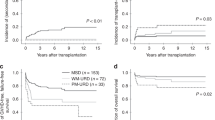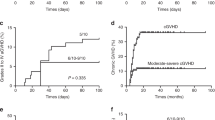Abstract
Severe aplastic anemia (SAA) is a BM failure syndrome in which allo-SCT remains a highly effective curative option. Its application remains limited by donor availability and by the potential for treatment-related morbidity and mortality. The improved outcomes with unrelated transplantation are a result of the advent of molecular donor–recipient matching, generation of effective novel conditioning regimens, improvement of supportive care and expansion of the donor registry. Decision making regarding the earlier use of unrelated transplant procedures is rapidly evolving. This paper reviews critical data relevant to these treatment options and recommends early consideration of related SCT for patients with SAA who show failure of immune suppressive therapy.
This is a preview of subscription content, access via your institution
Access options
Subscribe to this journal
Receive 12 print issues and online access
$259.00 per year
only $21.58 per issue
Buy this article
- Purchase on Springer Link
- Instant access to full article PDF
Prices may be subject to local taxes which are calculated during checkout







Similar content being viewed by others
References
Armand P, Antin J . Allogeneic stem cell transplantation for aplastic anemia. Biol Blood Marrow Transplant 2007; 13: 505–516.
Kahl C, Leisenring W, Deeg HJ, Chauncey TR, Flowers ME, Martin PJ et al. Cyclophosphamide and antithymocyte globulin as a conditioning regimen for allogeneic marrow transplantation in patients with aplastic anemia: a long-term follow up. Br J Haematol 2005; 130: 747–751.
Kröger N, Zabelina T, Renges H, Krüger W, Kordes U, Rischewski J et al. Long-term follow-up of allogeneic stem cell transplantation in patients with severe aplastic anemia after conditioning with cyclophosphamide plus antithymocyte globulin. Ann Hematol 2002; 81: 627–631.
Storb R, Blume KG, O’Donnell MR, Chauncey T, Forman SJ, Deeg HJ et al. Cyclophosphamide and antithymocyte globulin to condition patients with aplastic anemia for allogeneic marrow transplantations: the experience in four centers. Biol Blood Marrow Transplant 2001; 7: 39–44.
Gupta V, Ball SE, Yi QL, Sage D, McCann SR, Lawler M et al. Favorable effect on acute and chronic graft-versus-host disease with cyclophosphamide and in vivo anti-CD52 monoclonal antibodies for marrow transplantation for HLA-identical sibling donors for acquired aplastic anemia. Biol Blood Marrow Transplant 2004; 10: 867–876.
Inamoto Y, Suzuki R, Kuwatsuka Y, Yasuda T, Takahashi T, Tsujimura A et al. Long-term outcome after bone marrow transplantation for aplastic anemia using cyclophosphamide and total lymphoid irradiation as conditioning regimen. Biol Blood Marrow Transplant 2008; 14: 43–49.
Locatelli F, Bruno B, Zecca M, Van-Lint MT, McCann S, Arcese W et al. Cyclosporin A and short-term methotrexate versus cyclosporine A as graft versus host disease prophylaxis in patient with severe aplastic anemia given allogeneic bone marrow transplantation from an HLA-identical sibling: results of a GITMO/EBMT randomized trial. Blood 2000; 96: 1690–1697.
Champlin RE, Perez WS, Passweg JR, Klein JP, Camitta BM, Gluckman E et al. Bone marrow transplantation for severe aplastic anemia: a randomized controlled study of conditioning regimens. Blood 2007; 109: 4582–4585.
Bacigalupo A, Bruno B, Saracco P, Di Bona E, Locasciulli A, Locatelli F et al. Antilymphocyte globulin, cyclosporine, prednisolone, and granulocyte colony-stimulating factor for severe aplastic anemia: an update of the GITMO/EBMT study on 100 patients. European Group for Blood and Marrow Transplantation (EBMT) Working Party on Severe Aplastic Anemia and the Gruppo Italiano Trapianti di Midolio Osseo (GITMO). Blood 2000; 95: 1931–1934.
Frickhofen N, Heimpel H, Kaltwasser JP, Schrezenmeier H . Antithymocyte globulin with or without cyclosporine A: 11-year follow-up of a randomized trial comparing treatments of aplastic anemia. Blood 2003; 101: 1236–1242.
Saracco P, Quarello P, Iori P, Zecca M, Longoni D, Svahn J et al. Cyclosporin A response and dependence in children with acquired aplastic anaemia: a multicentre retrospective study with long-term observation flow-up. Br J Haematol 2008; 140: 197–205.
Rosenfeld S, Follman D, Nunez O, Young NS . Antithymocyte globulin and cyclosporine for severe aplastic anemia: association between hematologic response and long-term outcome. JAMA 2003; 289: 1130–1135.
Maury S, Balère-Appert ML, Chir Z, Boiron JM, Galambrun C, Yakouben K et al. Unrelated stem cell transplantation for severe acquired aplastic anemia: improved outcome in the era of high-resolution HLA matching between donor and recipient. Haematologica 2007; 92: 589–596.
Viollier R, Socié G, Tichelli A, Bacigalupo A, Korthof ET, Marsh J et al. Recent improvement in outcome of unrelated donor transplantation for aplastic anemia. Bone Marrow Transplant 2008; 41: 45–50.
Kojima S, Matsuyama T, Kato S, Kigasawa H, Kobayashi R, Kikuta A et al. Outcome of 154 patients with severe aplastic anemia who received transplants from unrelated donors: the Japan Marrow Donor Program. Blood 2002; 100: 799–803.
Bacigalupo A, Locatelli F, Lanino E, Marsh J, Socié G, Maury S et al. Fludarabine, cyclophosphamide and anti-thymocyte globulin for alternative donor transplants in acquired severe aplastic anemia: a report from the EBMT-SAA Working Party. Bone Marrow Transplant 2005; 36: 947–950.
Kang HJ, Shin HY, Choi HS, Ahn HS . Fludarabine, cyclophosphamide plus thymoglobulin conditioning regimen for unrelated bone marrow transplantation in severe aplastic anemia. Bone Marrow Transplant 2004; 34: 939–943.
Gupta V, Ball SE, Sage D, Ortin M, Freires M, Gordon-Smith EC et al. Marrow transplants from matched unrelated donors for aplastic anaemia using alemtuzumab, fludarabine and cyclophosphamide based conditioning. Bone Marrow Transplant 2005; 35: 467–471.
Chan KW, Li CK, Worth LL, Chik KW, Jeha S, Shing MK et al. A fludarabine-based conditioning regimen for severe aplastic anemia. Bone Marrow Transplant 2001; 27: 125–128.
Urban C, Benesch M, Sykora KW, Schwinger W, Lackner H . Non-radiotherapy conditioning with stem cell transplantation from alternative donors in children with refractory severe aplastic anemia. Bone Marrow Transplant 2005; 35: 591–594.
Vassiliou GS, Webb DK, Pamphilon D, Knapper S, Veys PA . Improved outcome of alternative donor bone marrow transplantation in children with severe aplastic anaemia using a conditioning regimen containing low-dose total body irradiation, cyclophosphamide and Campath. Br J Haematol 2001; 114: 701–705.
Deeg HJ, Anasetti C, Petersdorf E, Storb R, Doney K, Hansen JA et al. Cyclophosphamide plus ATG conditioning is insufficient for sustained hematopoietic reconstitution in patients with severe aplastic anemia transplanted with marrow from HLA-A, B, DRB matched unrelated donors. Blood 1994; 83: 3417–3418.
Roch N, Salameire D, Gressin R, Morand P, Epaulard O, Pavese P et al. Fatal adenoviral and enteroviral infections and an Epstein-Barr positive large B-cell lymphoma after alemtuzumab treatment in a patient with refractory Sézary syndrome. Scand J Infect Dis 2008; 40: 343–346.
Myers GD, Krance RA, Weiss H, Kuehnle I, Demmler G, Heslop HE et al. Adenovirus infection rates in pediatric recipients of alternative donor allogeneic bone marrow transplants receiving either antithymocyte globulin (ATG) or alemtuzumab (Campath). Bone Marrow Transplant 2005; 36: 1001–1008.
Avivi I, Chakrabarti S, Milligan DW, Waldmann H, Hale G, Osman H et al. Incidence and outcome of adenovirus disease in transplant recipients after reduced-intensity conditioning with alemtuzumab. Biol Blood Marrow Transplant 2004; 10: 186–194.
Cavalli-Björkman N, Osby E, Lundin J, Kalin M, Oserborg A, Gruber A . Fatal adenovirus infection during alemtuzumab (anti-CD52 monoclonal antibody) treatment of a patient with fludarabine-refractory B-cell lymphocytic leukemia. Med Oncol 2002; 19: 277–280.
Weisel KC, Weidmann E, Anagnostopoulos I, Kanz L, Pezzutto A, Subklewe M . Epstein-Barr virus-associated B-cell lymphoma secondary to FCD-C therapy in patients with peripheral T-cell lymphoma. Int J Hematol 2008; 88: 434–440.
Kluin-Nelemans HC, Coenen JL, Boers JE, van Imhoff GW, Rosati S . EBV-positive immunodeficiency lymphoma after alemtuzumab-CHOP therapy for peripheral T-cell lymphoma. Blood 2008; 112: 1039–1041.
Ghobrial IM, Otteman LA, White WL . An EBV-positive lymphoproliferative disorder after therapy with alemtuzumab. N Engl J Med 2003; 349: 2570–2572.
Locasciulli A, Oneto R, Bacigalupo A, Socié G, Korthof E, Bekassy A et al. Outcome of patients with acquired aplastic anemia given first line bone marrow transplantation or immunosuppressive treatment in the last decade; a report from the European Group for Blood and Marrow Transplantation (EBMT). Haematologica 2007; 92: 11–18.
Bacigalupo A . Aplastic anemia: pathogenesis and treatment. Am Soc Hematol Educ Prog Book 2007, 23–28.
Kennedy-Nasser AA, Leung KS, Mahajan A, Weiss HL, Arce JA, Gottschalk S et al. Comparable outcomes of matched-related and alternative donor stem cell transplantation for pediatric severe aplastic anemia. Biol Blood Marrow Transplant 2006; 12: 1277–1284.
Hansen JA, Gooley TA, Martin PJ, Appelbaum F, Chauncey TR, Clift RA et al. Bone marrow transplants from unrelated donors for patients with chronic myeloid leukemia. N Engl J Med 1998; 338: 962–968.
Gluckman E, Broxmeyer HA, Auerbach AD, Friedman HS, Douglas GW, Devergie A et al. Hematopoietic reconstitution in a patient with Fanconi's anemia by means of umbilical-cord blood from an HLA-identical sibling. N Engl J Med 1989; 321: 1174–1178.
Neudorf SM, Blatt J, Corey S, Koehler M, Wollman M, Rosner G et al. Graft failure after an umbilical cord blood transplant in a patient with severe aplastic anemia. Blood 1995; 85: 2991–2992.
Yoshimi A, Kojima S, Taniguchi S, Hara J, Matsui T, Takahashi Y et al. Unrelated cord blood transplantation for severe aplastic anemia. Biol Blood Marrow Transplant 2008; 14: 1057–1063.
Ruggeri A, de Latour RP, Rocha V, Larghero J, Robin M, Rodrigues CA et al. Double cord blood transplantation in patients with high risk bone marrow failure syndromes. Br J Haematol 2008; 143: 404–408.
Chan KW, McDonald L, Lim D, Grimley MS, Grayson G, Wall DA et al. Unrelated cord blood transplantation in children with idiopathic severe aplastic anemia. Bone Marrow Transplant 2008; 42: 589–595.
Tajika K, Mizuki T, Nakayama K, Yamaguchi H, Dan K . Umbilical-cord blood cell transplantation conditioned with a reduced intensity-regimen is a practical salvage therapy for severe aplastic anemia refractory to immunosuppressive therapy with antithymocyte globulin/ciclosporin. J Nippon Med Sch 2007; 74: 424–429.
Ohga S, Ichino K, Goto K, Hattori S, Nomura A, Takada H et al. Unrelated donor cord blood transplantation for childhood severe aplastic anemia after a modified conditioning. Pediatr Transplant 2006; 10: 497–500.
Mao P, Zhu Z, Wang H, Wang S, Mo W, Ying Y et al. Sustained and stable hematopoietic donor-recipient mixed chimerism after unrelated cord blood transplantation for adult patients with severe aplastic anemia. Eur J Haematol 2005; 75: 430–435.
Mao P, Wang S, Wang S, Zhu Z, Liv Q, Xuv Y et al. Umbilical cord blood transplant for adult patients with severe aplastic anemia using anti-lymphocyte globulin and cyclophosphamide as conditioning therapy. Bone Marrow Transplant 2004; 33: 33–38.
Ohnuma K, Isoyama K, Nishihira H . Cord blood transplantation from HLA-mismatched unrelated donors. Leuk Lymphoma 2002; 43: 1029–1034.
Gluckman E, Horowitz MM, Champlin RE, Hows JM, Bacigalupo A, Biggs JC et al. Bone marrow transplantation for severe aplastic anemia: influence of conditioning and graft-versus-host disease prophylaxis regimens on outcome. Blood 1992; 79: 269–275.
Kobayashi R, Yabe H, Hara J, Morimoto A, Tsuchida M, Mugishima H et al. Preceding immunosuppressive therapy with antithymocyte globulin and ciclosporin increases the incidence of graft rejection in children with aplastic anaemia who underwent allogeneic bone marrow transplantation form HLA-identical siblings. Br J Haematol 2006; 135: 693–696.
Marsh JC, Ball SE, Cavenagh J, Darbyshire P, Dokal I, Gordon-Smith EC et al. Guidelines for the diagnosis and management of aplastic anaemia. Br J Haematol 2009; 147: 43–70.
Author information
Authors and Affiliations
Corresponding author
Ethics declarations
Competing interests
The authors declare no conflict of interest.
Rights and permissions
About this article
Cite this article
Meyers, G., Maziarz, R. Is it time for a change? The case for early application of unrelated allo-SCT for severe aplastic anemia. Bone Marrow Transplant 45, 1479–1488 (2010). https://doi.org/10.1038/bmt.2010.134
Received:
Accepted:
Published:
Issue Date:
DOI: https://doi.org/10.1038/bmt.2010.134



